The manta ray is large, graceful and absolutely beautiful. If you love them as much as we do, then keep reading!
In this article we cover it’s anatomy, some facts, how to interact with them and more.
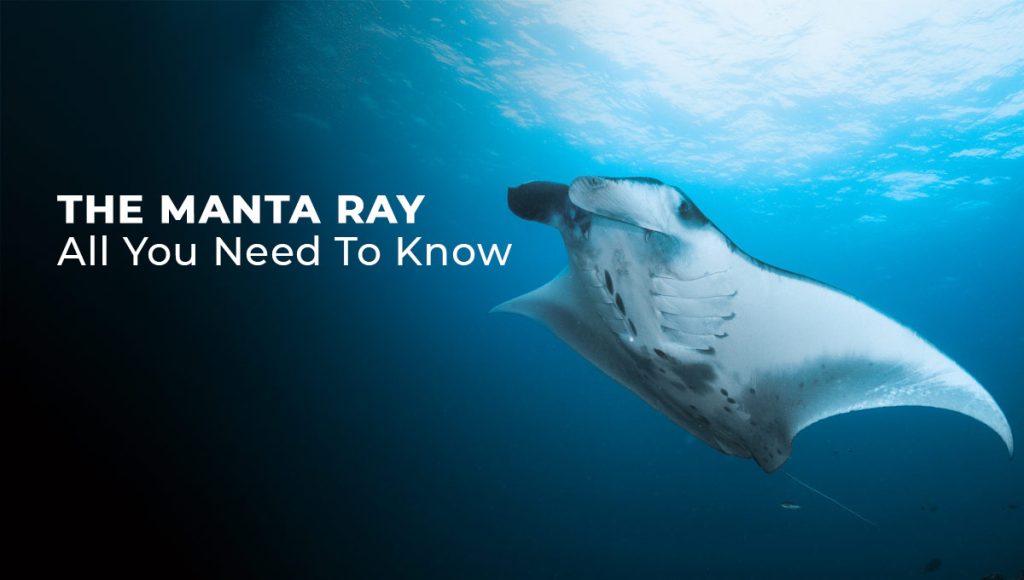
What is a Manta Ray?
A manta ray is a large, graceful marine animal that belongs to the family Mobulidae.
It is known for its flat, diamond-shaped body that can reach up to 23 feet in width and 3,000 pounds in weight.
They are found in warm waters all over the world and is known for its unique feeding style. Unlike other rays, it does not have a stinging barb on its tail and does not pose a threat to humans.
The Anatomy of Manta Rays

The pectoral fins of a manta ray are one of the largest and most distinguishing features of this majestic marine creature. These fins, located on each side of the body, can measure up to 23 feet in length and are used for propulsion and steering
The cephalic lobe of a manta ray is a distinctive projection on the front of its head, which is used for filter feeding. This lobe is covered in numerous small pores, through which the manta ray sucks in water while feeding on plankton.
The dorsal fin is a prominent feature of this majestic marine animal and are designed for agility and maneuverability.
Manta rays have a flattened body shape that can reach up to 7 meters in width. They have a head with large, forward-facing eyes and wide, flat cephalic fins that give them the appearance of horns. Their mouth is located on the underside of their body, and they have several rows of small, pointed teeth.
They have five gill slits on the underside of their body, which they use for respiration. Manta Rays also have a streamlined body with a powerful tail that allows them to swim quickly and efficiently through the water.
The skin is smooth and covered in tiny, tooth-like scales called dermal denticles, which help to protect them against predators and parasites.
Overall, the anatomy of manta rays is perfectly adapted for their life in the open ocean, allowing them to glide through the water with speed and grace.
Types of Mantas
There are two main types: the reef manta (Manta alfredi) and the giant oceanic manta (Manta birostris).
The reef manta is smaller, with a wingspan of up to 3 meters, and can be found in shallow waters near coral reefs.
Giant oceanic mantas, on the other hand, can reach a wingspan of up to 7 meters and prefers deeper waters in the open ocean.
Both types of manta rays are filter feeders, using their large mouths to gulp in plankton and small fish. They are also known for their acrobatic jumps and elaborate courtship dances.
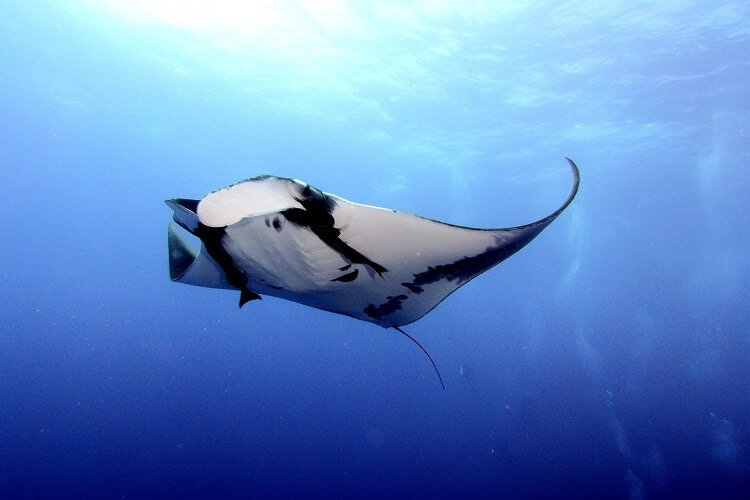
They have their own unique patterns
Manta rays are known for their unique patterns, which can help researchers and scientists identify individual rays.
Each manta has a distinctive pattern on their underside, with a series of black spots and markings that are like a fingerprint. These patterns are not only unique to each individual ray but also remain relatively consistent throughout its lifetime.
These patterns have become increasingly important in the study and conservation of manta rays, helping researchers track their movements, monitor their populations and better understand their behavior.
Overall, the unique patterns of manta rays make them a fascinating and important species to study and protect.
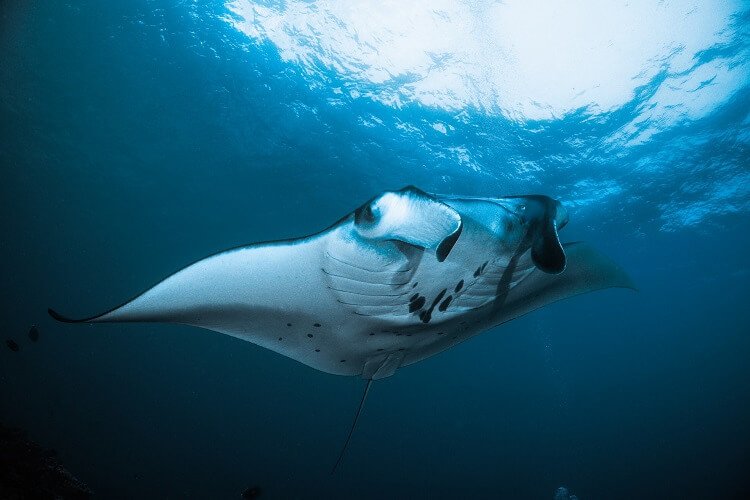
The nature of these unique spots enable scientists to identify every individual manta just by photographing their ventral surfaces. This simple, non-invasive technique allows certified, non-professional divers to assist with the ongoing research and conservation efforts by submitting their images.
Manta Trust created the IDtheManta initiative to utilize the power of citizen science (also known as community science or crowd science) to aid in the research and conservation of the world’s Manta Rays.
Today, they receive over 5,000 image submissions every year. If you have an image to submit or would like to know more, you can read it here : Manta Trust Photo Id
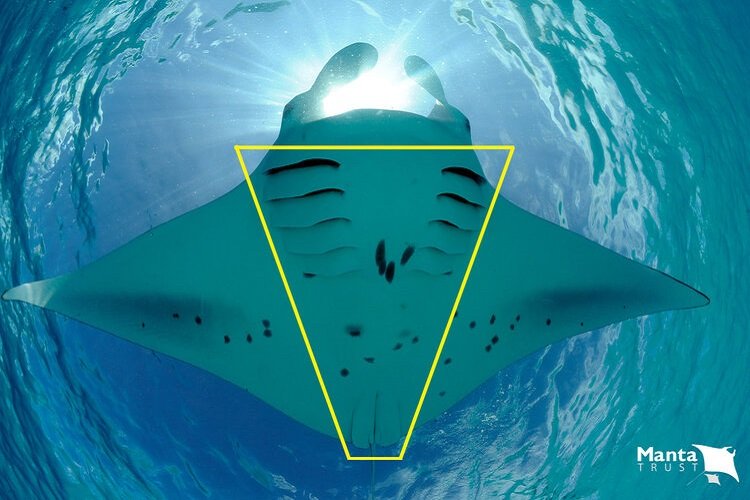
When trying to photo ID manta rays, it is essential to capture clear and detailed images of their ventral side, specifically the abdominal area to capture the unique spots and to try identify the sex.
It is important to take note of the location, date, and time of the sighting as this can be used to track the manta ray’s movements.
To obtain clear photos, it is recommended to get as close to the manta ray as possible without interfering with their natural behavior.
Once you have the image, you can then submit your image on the Manta Trust website.
What do they eat?
Manta rays are filter feeders, which means they consume large amounts of plankton. They use their wide, flat mouths to filter tiny organisms such as krill, copepods, and small fish from the water.
They also have long, ribbon-like structures called cephalic fins, which they use to direct water and food towards their mouth. They typically feed near the surface of the ocean, where plankton concentrations are highest.
Manta rays are classified as ‘elasmobranchs‘, which means they are related to sharks, although their diets are quite different. Unlike sharks, manta rays do not have teeth, and they do not actively hunt for prey.
Instead, they rely on filter feeding to extract the nutrients they need from the water column.
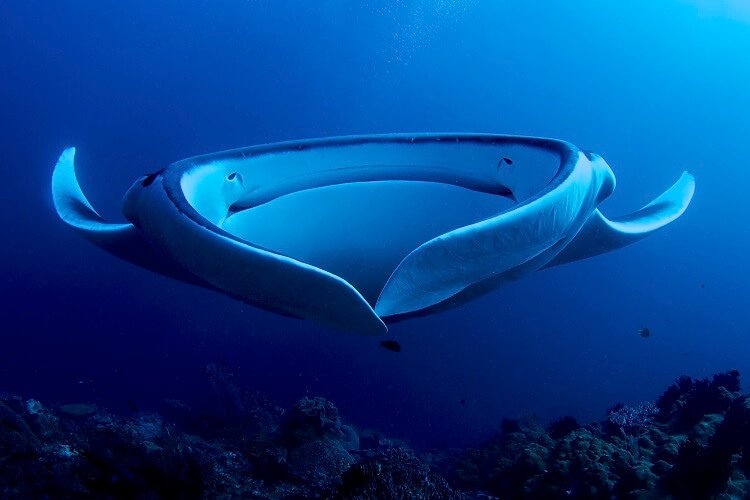
How do Manta Rays mate?
Manta rays are highly social animals that display complex mating behavior. During the breeding season, males will often pursue and compete for the attention of a female.
This competition may include chasing, circling, and eventually biting the female in an effort to mate. Once the male successfully mates with the female, he will accompany her for several hours, swimming alongside her while holding onto her with his specialized claspers.
Interestingly, female mantas have been observed displaying a unique behavior known as “flirting.” This behavior involves a female approaching a male and exposing her belly in a playful and alluring way, sometimes even jumping out of the water in a sort of dance.
The mating can be difficult to observe due to the animals’ elusive nature and their preference for deeper waters, but researchers are continuing to study these fascinating creatures to better understand their reproductive biology and social behavior.
How do they give birth?
Manta rays are oviparous, giving birth by laying eggs which hatch inside the mother and are born fully formed.
Females give birth to one or two live pups with a wingspan of up to 5 feet. The gestation period can last up to a year, during which nutrients and oxygen are provided via placenta.
The newborns are born tail-first to prevent water inhalation. Due to their low reproductive rate, females give birth every two to five years mandating conservation efforts.
Here are some more Manta Ray facts
1. Manta rays can grow up to 23 feet (7 meters) in width and weigh up to 5,500 pounds (2,500 kg).
2. They have no teeth, instead they use their gill rakers to filter their food from the water.
3. Mantas have a high brain-to-body ratio, making them intelligent and curious animals.
4. Capable of swimming up to speeds of 24 mph (40 km/h).
5. Manta rays can live up to 50 years.
6. Manta rays are related to sharks and have a similar skeleton structure.
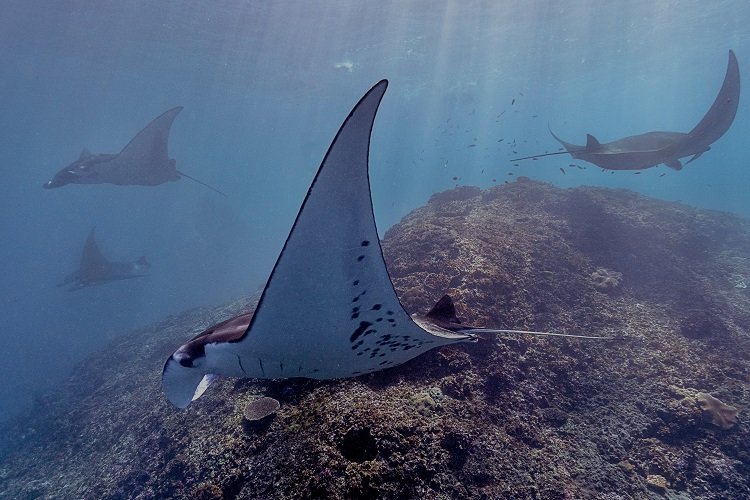
Threats and how we can help.
Manta rays are being threatened by overfishing, bycatch, unregulated tourism activities and habitat destruction.
To help protect these gentle giants, we can take several actions. First, we can support organizations that work to protect manta rays and their habitats, such as the Manta Trust and the Marine Megafauna Foundation.
We can also reduce our consumption of fish products, which can contribute to overfishing. Avoiding single-use plastics, such as straws and bags, can also help reduce plastic pollution that harms manta rays and their habitats.
Finally, we can advocate for the creation of marine protected areas and sustainable fisheries management practices to prevent further harm to manta rays and other ocean wildlife. By taking these actions, we can help ensure the survival of these beautiful creatures for generations to come.
Good Dive Etiquette
When interacting with manta rays during a dive, it is important to remember that they are wild animals and should be treated with respect and caution.
Approach them slowly and calmly, and avoid touching them or preventing them from swimming freely.
Never chase or try grabbing onto them, as this can cause stress and harm to the animals. Instead, observe from a distance and let them come to you if they feel comfortable.
If they do approach, try to stay low and out of their way.
With proper respect and caution, interacting with manta rays can be a thrilling and memorable experience for both humans and marine life.
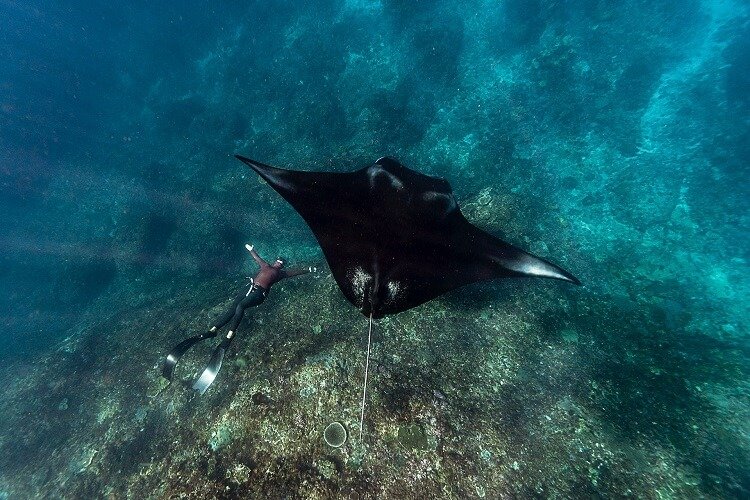
Best Places To Dive With Them
Manta rays can be seen in several locations around the world. Some of the best places are:
1. Indonesia: Komodo National Park, Raja Ampat, and Nusa Islands are great places to see manta rays.
2. Maldives: This island nation in the Indian Ocean is a popular destination for manta ray sightings.
3. Mexico: In Mexico, Isla Mujeres, Cabo San Lucas, and Socorro Island are where you can spot manta rays.
4. Mozambique: Tofo is a small town in Mozambique that has become famous for its manta ray sightings.
5. Hawaii: The Kona coast on Hawaii’s Big Island is reputed to have the highest concentration of manta rays in the world.
When planning a trip to see mantas, it’s important to visit during the right season. We can help plan your next dive holiday to give you the best chance to interact with them.


